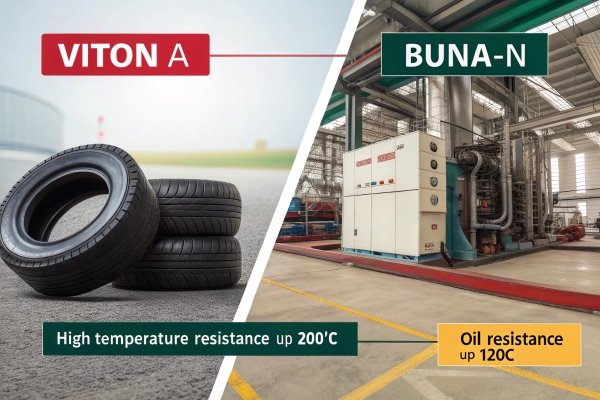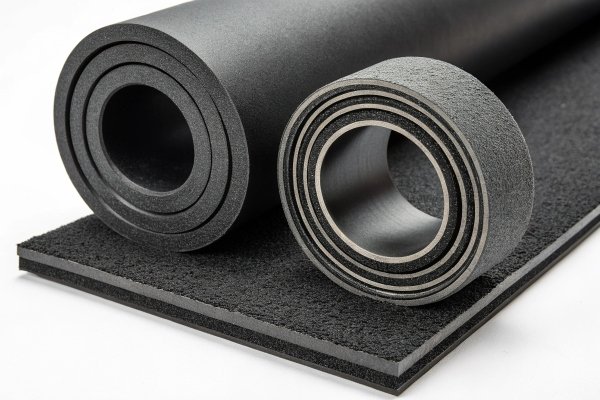If you're in the rubber industry, you’ve probably come across Viton1 and Buna-N2. But what sets them apart? In this post, I’ll walk you through the key differences to help you choose the best material for your needs.
Viton and Buna-N are both synthetic rubbers but differ in chemical composition, temperature resistance, and suitability for specific industrial applications. Let’s dive into the key distinctions.
Before we get into the specifics, let’s first explore what Buna-N actually is. Understanding the basics will help you compare it better with Viton.
What is the meaning of Buna-N?
What does Buna-N really mean? Let’s take a quick look at its origins and significance.
Buna-N, also known as Nitrile Rubber (NBR), is a synthetic rubber made from butadiene and acrylonitrile. It’s popular for its excellent resistance to oils, fuels, and chemicals.
Buna-N is a synthetic copolymer of butadiene and acrylonitrile. It was created to meet the need for a rubber that could handle oils, fuels, and chemicals that natural rubber couldn’t. This material is commonly used in automotive, industrial seals, and fuel hoses. Its high resistance to oils and fuels makes it ideal for the oil and gas industry, as well as for applications in mechanical seals and O-rings.
Is Buna-N natural or synthetic?
Is Buna-N a natural product? Let's clear up the confusion.
Buna-N is a synthetic rubber, created through a chemical process. Unlike natural rubber, it is not derived from rubber trees.
The main difference between natural rubber and synthetic rubber like Buna-N is in how they’re produced. While natural rubber comes from latex harvested from rubber trees, Buna-N is made by polymerizing butadiene and acrylonitrile in a lab. This gives it specific advantages, like improved resistance to chemicals and oils, which natural rubber lacks.
Who invented buna rubber?
Ever wondered who came up with Buna-N? Let’s take a quick look at its inventor and its development.
Buna rubber3, the precursor to Buna-N, was invented by chemists at the German chemical company BASF during the 1930s.
The invention of Buna rubber came as a result of the need for synthetic rubber during World War II. Dr. Eduard Tschunkur and his team at BASF developed the first synthetic rubber that could replace natural rubber in critical applications. This paved the way for the development of Buna-N, which quickly became a preferred material for industrial and automotive uses.
Is Buna-N the same as neoprene?
Are Buna-N and Neoprene4 the same? Here’s a quick comparison of the two.
No, Buna-N and Neoprene are not the same. While both are synthetic rubbers, they differ in chemical composition and resistance to various elements.
Buna-N is primarily known for its oil and fuel resistance, making it ideal for automotive and industrial seals. Neoprene, on the other hand, is more versatile in terms of weather and ozone resistance, making it a good choice for outdoor applications. Both have unique properties, so your choice will depend on the specific requirements of your application.
Is Buna-N vulcanized rubber?
Does Buna-N undergo vulcanization? Let's break it down.
Yes, Buna-N is vulcanized during its production process. Vulcanization improves its durability and heat resistance.
Key Points about Buna-N Vulcanization:
- Improved Properties: Vulcanization significantly enhances the tensile strength, tear resistance, and wear resistance of Buna-N. It also improves its aging resistance, allowing it to maintain performance in challenging environments.
- Processing: The vulcanization process involves heating the rubber with the vulcanizing agents at specific temperatures and times to ensure optimal cross-linking without over-vulcanization.
- Applications: Vulcanized Buna-N is widely used in applications requiring oil resistance and durability, such as automotive seals, gaskets, and O-rings.
Buna-N is indeed vulcanized rubber, and this process is essential for enhancing its functional properties for various industrial applications.
Is Buna-N better than EPDM?
So, is Buna-N really better than EPDM5 for certain applications? Let’s compare.
It depends on the application. Buna-N is great for oil and chemical resistance, while EPDM excels in weather and ozone resistance.
| Property | Buna-N (Nitrile Rubber) | EPDM (Ethylene Propylene Diene Monomer) |
|---|---|---|
| Basic Composition | Copolymer of butadiene and acrylonitrile | Copolymer of ethylene, propylene, and diene |
| Oil Resistance | Excellent; suitable for petroleum-based fluids and lubricants | Poor; not suitable for contact with oils and greases |
| Chemical Resistance | Moderate; less resistant to acids and bases | Good; resistant to acids, bases, and cleaning agents |
| Environmental Resistance | Poor; susceptible to ozone and UV damage | Excellent; resistant to ozone, UV radiation, and weathering |
| Temperature Range | -40°C to 107°C (-40°F to 225°F) | -48°C to 135°C (-55°F to 275°F) |
| Physical Properties | Good tensile strength and tear resistance | High abrasion resistance and tensile strength |
| Applications | Fuel hoses, hydraulic seals, O-rings | Building seals, automotive weatherstripping, roofing materials |
| Cost | Generally lower cost | Typically higher cost |
Summary
- Buna-N is ideal for applications involving oil and petroleum products due to its excellent oil resistance but performs poorly in outdoor environments.
- EPDM is better suited for outdoor applications with strong resistance to weathering and chemicals, while not being suitable for oil exposure.
Choose the material based on the specific requirements of your application.
What is the best rubber for friction?
Looking for a rubber with excellent friction properties? Let’s explore which type of rubber performs best in this area.
In terms of friction, rubber materials like natural rubber and certain types of nitrile rubber are the top choices due to their high coefficient of friction.
Rubber’s friction properties depend on its hardness and composition. Natural rubber6, with its high grip and tackiness, is often used in applications like tire treads. Similarly, certain nitrile rubbers can offer good friction characteristics, especially when blended with other materials to improve durability. Choosing the right rubber for friction depends on factors like wear resistance and performance under pressure.
What is the toughest rubber material?
Wondering which rubber material is the toughest? Let’s find out which one stands up to the harshest conditions.
The toughest rubber materials are usually high-performance elastomers like Polyurethane and neoprene, which offer excellent wear and tear resistance.
Dive Deeper section for h2: Polyurethane rubber is often considered one of the toughest due to its outstanding abrasion resistance and ability to withstand high impacts. Neoprene, with its durability and resistance to environmental stress, is also among the toughest materials. These rubbers are often used in demanding applications like heavy machinery and automotive components where high wear resistance is critical.
Conclusion
To sum up, while Viton A and Buna-N are both synthetic rubbers, their properties and applications vary. Depending on your needs—whether it’s fuel resistance, outdoor durability, or friction resistance—you’ll need to choose the rubber that best suits your environment.
-
Viton A is a high-performance fluoroelastomer used in extreme conditions. This resource will help you understand its high resistance to chemicals and heat. ↩
-
Buna-N is a synthetic rubber known for its oil and fuel resistance. It's commonly used in seals and gaskets for automotive and industrial applications. ↩
-
Buna rubber was developed during the 1930s and marked the beginning of synthetic rubbers being used in place of natural rubber. ↩
-
Neoprene is another synthetic rubber known for its weather resistance and is widely used in outdoor applications. ↩
-
EPDM is a type of synthetic rubber that excels in weather resistance and is ideal for outdoor environments. ↩
-
Natural rubber is derived from latex and is widely used for applications requiring high friction ↩










